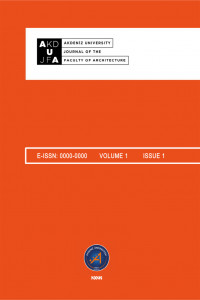Research Article
DOĞAN KUBAN’IN “TÜRK HAYAT’LI EVİ” ANLAYIŞININ ÇAĞDAŞ MİMARLIK TARİHİ YAKLAŞIMLARI ÜZERİNDEN DEĞERLENDİRİLMESİ
Abstract
Geleneksel konut mimarisinin oluşumunda etkili fiziksel faktörler olan malzeme, iklim ve coğrafyanın yanında sosyal faktörler, tarihsel ve kültürel değerler de bu oluşumu şekillendiren önemli etkenler arasında yer almaktadır. Konut kullanıcılarının dönem içerisindeki tarihsel, sosyal ve kültürel yaşam süreçlerine de ışık tuttuğundan, geleneksel konut yapısının, bu bakış açısıyla analiz edilmesi son dönemlerde yapılan çalışmalarda önem kazanmıştır. 20. yüzyılın başlarında ve öncesinde mimarlık tarihi yazımında, daha anıtsal binalara yer verilirken 20. yüzyılın ikinci yarısından itibaren geleneksel konut mimarisi de mimarlık tarihi yazımında değer görmeye başlamıştır. Türkiye mimarlığı tarihinin tüm dönemleri üzerine çalışmış olması açısından Doğan Kuban rasyonalist mimarlık tarihçiliğinin Türkiye’deki en önemli temsilcilerindendir. Bu çalışma kapsamında ise, Türkiye’de bu dönemlerde Doğan Kuban tarafından yazılmış olan “Türk Hayatlı Evi” adlı eseri yöntemsel açıdan çözümlenmeye çalışılacaktır. “Türk Evi”nin Leach’in ortaya koyduğu hangi mimarlık tarihi yazımı yaklaşımları ile incelendiği ortaya konarak, bunların konunun tarihsel bağlamı içerisinde açıklanmasındaki etkileri tartışılacaktır.
Keywords
Thanks
Bu makale, Akdeniz Üniversitesi Mimarlık Anabilim dalı doktora dersi olan MİM 7013 kodlu Mimarlık Tarihi Yazımında Metodoloji dersi kapsamında Prof. Dr. Kemal Reha KAVAS’ın katkıları ile oluşturulmuştur.
References
- Arnold, D., 2003. Reading the Past, What is Architectural History. London & New York: Routledge, pp. 1-13.
- Bozdoğan, S., 1999. Architectural History in Professional Education: Reflections on Postcolonial Challenges to the Modern Survey. Journal of Architectural Education 52(4): 207-215.
- Eldem, S.H., 1954. Türk Evi Plan Tipleri. İ.T.Ü. Mimarlık Fakültesi Baskı Atölyesi, İstanbul, s: 93.
- Günay, R., 2001. Osmanlı Konut Mimarisinde Ahşap Kullanımının Sürekliliği. M. Kiel, N. Landman, H. Theusnissen (Dü.), EJOS IV, Proceeding of the 11th International Congress of Turkish Art içinde, Utrecht, sf. 1-22.
- Karpuz, H., 1999. Türk evi, Osmanlı Evi. Osmanlı, Cilt: 10, Ankara, s.450-456.
- Kavas, K.R., 2010. An Evaluation Of The 20th Century Perspectives Of Architectural Historiography And The Research In Vernacular Architecture. Akdeniz Sanat, ss.117-128.
- Kostof, S.,1985), A History of Architecture, Settings and Rituals. N. Y. Oxford: Oxford Univ. Press. p.788.
- Kuban, D., 1995. Türk Hayat’lı Evi. Mısırlı Matbaacılık A.Ş., İstanbul, p.279.
- Küçükerman, Ö., 1988. Kendi Mekanı Arayışı İçinde Türk Evi. Türkiye Turizm ve Otomobil Kurumu, İstanbul, 27-47.
- Leach, A., 2015. Mimarlık Tarihi Nedir?. (Çev.) Doğan, H., İstanbul, Koç Üniversitesi Yayınları, p.150.
- Payne, A., 1999. Architectural History and the History of Art: A Suspended Dialogue. The Journal of the Society of Architectural Historians 58 (3): 292-299.
- Sarıalioğlu, C., 2008. Historiyografik Bir Sorunsal Olarak:“Türk Evi”. Yıldız Teknik Üniversitesi Fen Bilimleri Enstitüsü Mimarlık Anabilim Dalı, İstanbul, Türkiye, pp.105.
- Sözen, M., Eruzun, C., 1992. Anadolu’da Ev ve İnsan. Emlak Bankası Yayınevi, İstanbul, p.311.
An Evaluation of Doğan Kuban's Approach to the "Turkish House with ‘Hayat’" through Contemporary Approaches of Architectural History
Abstract
In addition to the physical environment such as climate, geography and materials, which are effective in the formation of traditional residential architecture, social factors, historical and cultural values are among the important factors that shape this formation. Analyzing the traditional house structure from this point of view has gained importance in recent studies, as it sheds light on the historical, social and cultural life processes of the house users in the period. While more monumental buildings were included in architectural historiography at the beginning of the 20th century and before, from the second half of the 20th century, traditional residential architecture began to gain value in architectural historiography. Doğan Kuban is one of the most important representatives of rationalist architectural historiography in Turkey, as he has worked on all periods of the history of Turkish architecture. Within the scope of this study, the work named “Türk Hayatlı Evi”, which was written by Doğan Kuban during these periods in Turkey, will be tried to be analyzed in terms of method. By revealing which architectural historiography approaches that Leach put forward, "Turkish House" will be examined, and their effects on the explanation of the subject in its historical context will be discussed.
References
- Arnold, D., 2003. Reading the Past, What is Architectural History. London & New York: Routledge, pp. 1-13.
- Bozdoğan, S., 1999. Architectural History in Professional Education: Reflections on Postcolonial Challenges to the Modern Survey. Journal of Architectural Education 52(4): 207-215.
- Eldem, S.H., 1954. Türk Evi Plan Tipleri. İ.T.Ü. Mimarlık Fakültesi Baskı Atölyesi, İstanbul, s: 93.
- Günay, R., 2001. Osmanlı Konut Mimarisinde Ahşap Kullanımının Sürekliliği. M. Kiel, N. Landman, H. Theusnissen (Dü.), EJOS IV, Proceeding of the 11th International Congress of Turkish Art içinde, Utrecht, sf. 1-22.
- Karpuz, H., 1999. Türk evi, Osmanlı Evi. Osmanlı, Cilt: 10, Ankara, s.450-456.
- Kavas, K.R., 2010. An Evaluation Of The 20th Century Perspectives Of Architectural Historiography And The Research In Vernacular Architecture. Akdeniz Sanat, ss.117-128.
- Kostof, S.,1985), A History of Architecture, Settings and Rituals. N. Y. Oxford: Oxford Univ. Press. p.788.
- Kuban, D., 1995. Türk Hayat’lı Evi. Mısırlı Matbaacılık A.Ş., İstanbul, p.279.
- Küçükerman, Ö., 1988. Kendi Mekanı Arayışı İçinde Türk Evi. Türkiye Turizm ve Otomobil Kurumu, İstanbul, 27-47.
- Leach, A., 2015. Mimarlık Tarihi Nedir?. (Çev.) Doğan, H., İstanbul, Koç Üniversitesi Yayınları, p.150.
- Payne, A., 1999. Architectural History and the History of Art: A Suspended Dialogue. The Journal of the Society of Architectural Historians 58 (3): 292-299.
- Sarıalioğlu, C., 2008. Historiyografik Bir Sorunsal Olarak:“Türk Evi”. Yıldız Teknik Üniversitesi Fen Bilimleri Enstitüsü Mimarlık Anabilim Dalı, İstanbul, Türkiye, pp.105.
- Sözen, M., Eruzun, C., 1992. Anadolu’da Ev ve İnsan. Emlak Bankası Yayınevi, İstanbul, p.311.
There are 13 citations in total.
Details
| Primary Language | Turkish |
|---|---|
| Subjects | Architecture |
| Journal Section | Research Articles |
| Authors | |
| Publication Date | July 31, 2022 |
| Submission Date | May 8, 2022 |
| Published in Issue | Year 2022 Volume: 1 Issue: 1 |


